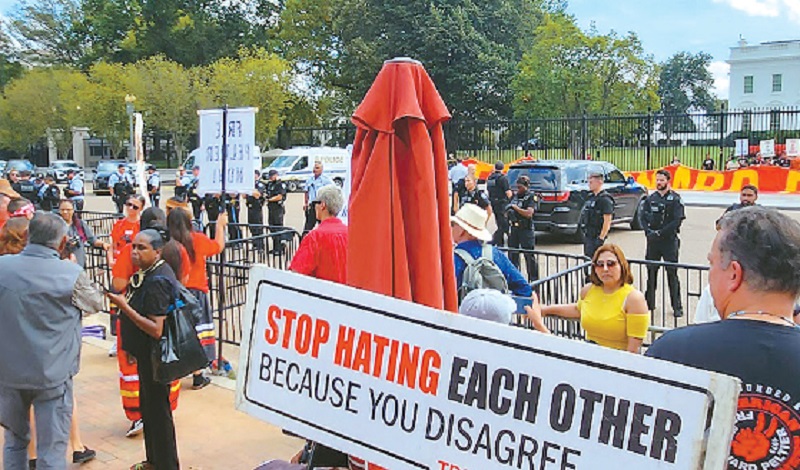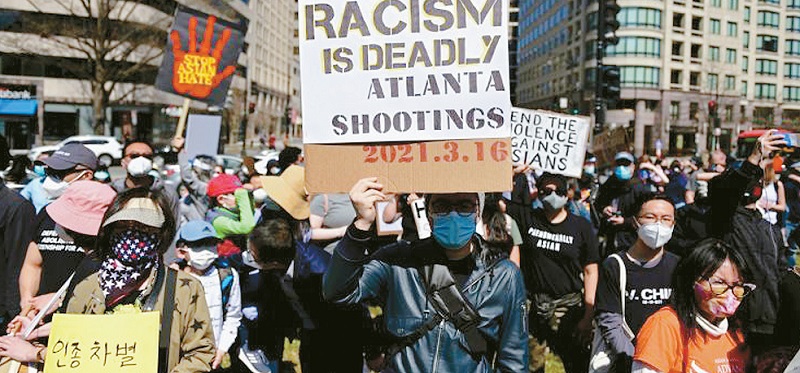Sociology teaches us that hatred or dislike of a particular race often stems from a lack of understanding, manifesting as a means to express fear and resistance. While there are political and ideological boundaries and conflicts, when people of diverse ethnic backgrounds fail to comprehend each other and lack opportunities to foster familiarity, confrontations and violence become inevitable. The past three years, marked by the pandemic and inflation, have further exacerbated these ethnic divisions. In a three-part series, Brian Choi, a political reporter from the Korea Daily, delves into the current state of Asian hate, with a visit to Washington DC, home to the federal government. –Ed.

From the very beginning of Pennsylvania Avenue, the echoes of drums and bullhorns resonated in the air. As I entered the north entrance to Lafayette Square, a typical city park where the footsteps of White House tourists blend with the sounds of nearby construction equipment, protest chants filled the air.
This picturesque 7-acre (8,500-square-meter) park has echoed the voices of Americans for over a century. Banners and pickets adorned with various slogans and messages are scattered around, while percussion instruments and megaphones compete for attention.
This is the scene just across the street from the Oval Office, where the U.S. President conducts his work in the White House. It’s a day after the 22nd anniversary of the September 11 attacks, an event that has become synonymous with hatred and violence.
The United States permits protests in close proximity to the residences and offices of key national leaders to safeguard fundamental rights. The area is overseen by the U.S. Park Service. With more than 200 attendees and a tendency for participants to be assertive, tensions were palpable on September 12 as a cordon of Secret Service troops formed in front of the White House fence.
This location is even more popular for protests than the Lincoln Memorial or the Capitol, as it provides the closest proximity to the president. Consequently, Lafayette Square has been a rallying point for every minority group in the United States.
From the Civil Rights Movement of the 1950s, the Women’s Suffrage Movement of the 1960s, the Vietnam War protests of the 1970s, the gay rights movement of the 2000s, to the recent protests against Asian discrimination and hate in the 2020s, the call for equality and peace has reverberated throughout the park.
According to data from the U.S. Park Service, the number of pre-registered protests ranged from 120 to 140 annually from 2016 to 2019, dipped in early 2020 with the onset of the pandemic, and then surged to 194 in 2021 and 207 in 2022. Protests with 25 or more participants must be pre-registered, but smaller groups or processions on sidewalks are not. Consequently, there are protests virtually every day, with three to six groups often taking turns for timed protests on weekends.
Korean-Americans were deeply disturbed by the Atlanta spa shooting in 2021 and traveled to the nation’s capital to protest, rallying under the banner of “No More Hate.” For Korean Americans in the United States, the most influential and widely attended protests in the 2000s were against Racism and Hate, a call that echoed the fundamental right to life.

The first large-scale rally took place near the White House on March 21, 2021, just five days after the Atlanta spa shooting claimed the lives of eight people, including four innocent Korean Americans. It was 10 months after the tragic death of George Floyd in 2020, which had sparked the Black Lives Matter (BLM) movement that had since gained momentum. The protests in June 2020 were so powerful that at one point, it was reported that then-President Donald Trump had taken refuge in an underground bunker. During that time, second-generation Korean Americans played a particularly active role in the protests, advocating for the rights of people of color and condemning discrimination.
Adrian Suh, who resided in Atlanta at the time and participated in protests in Washington DC and New York, recalls the intensity of the situation: “The march was primarily attended by second-generation Korean American activists, college students, and acquaintances, and I can still vividly remember the shocked and angry expressions on their faces.” He adds, “We all felt that without the protests, it would have been difficult to gain the attention of the authorities and sway public opinion.”
Protests against Asian hate crimes in Lafayette Square reached their peak in 2020 and 2021. According to data from the U.S. Park Service and local media reports, there were more than 240 Asian-led protests between 2020 and 2022, often conducted in collaboration with advocacy groups representing people of color. This included over 50 protests led by Korean American organizations like the Alliance for Asian American Justice (AAAJ).
As the pandemic led some politicians to label it the “Kungflu” and “China virus,” Asians were increasingly stigmatized as foreign carriers of the virus. This served as a wake-up call for some second-generation Asian-Americans.
“At the federal level, there was no sophisticated reporting and intelligence infrastructure to address these crimes, and efforts to develop one have only recently begun,” said U.S. Rep. Mark Takano (D-Calif.), who highlighted the harsh reality that “crimes not recorded in the system are not considered a problem.” The consensus is that “reform” entails not only changing sentiments but also a comprehensive overhaul or creation of new systems.
The most commonly voiced demand on the picket lines was “Stop,” according to Mark S. Chang, a member of the Maryland House of Delegates.
“It was a shock to many political leaders across the partisan spectrum, and it was a sleepless night for Asian-American leaders in particular, as we had believed it was a time when we would be recognized as equals. It was embarrassing, but we gained valuable insights from standing together at numerous protests.”
While 2021 did not witness the same level of sanctions or suppression against protesters as 2020 did, tensions ran high around the White House during the transition of the government, and the calls against discrimination towards people of color eventually reverberated through major cities, including the nation’s capital.
BY BRIAN CHOI [ichoi@koreadaily.com]





